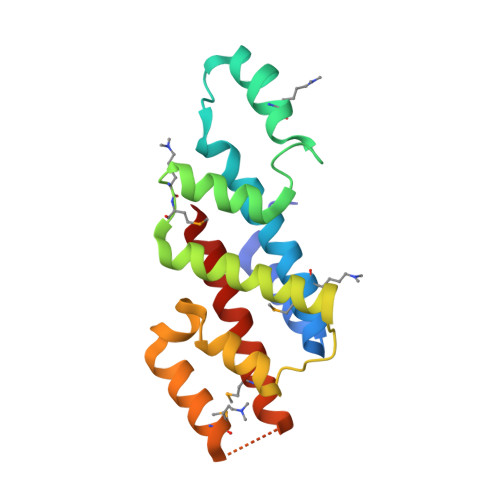The mannitol operon repressor MtlR belongs to a new class of transcription regulators in bacteria.
Tan, K., Clancy, S., Borovilos, M., Zhou, M., Horer, S., Moy, S., Volkart, L.L., Sassoon, J., Baumann, U., Joachimiak, A.(2009) J Biological Chem 284: 36670-36679
- PubMed: 19840941
- DOI: https://doi.org/10.1074/jbc.M109.062679
- Primary Citation of Related Structures:
3BRJ, 3C8G - PubMed Abstract:
Many bacteria express phosphoenolpyruvate-dependent phosphotransferase systems (PTS). The mannitol-specific PTS catalyze the uptake and phosphorylation of d-mannitol. The uptake system comprises several genes encoded in the single operon. The expression of the mannitol operon is regulated by a proposed transcriptional factor, mannitol operon repressor (MtlR) that was first studied in Escherichia coli. Here we report the first crystal structures of MtlR from Vibrio parahemeolyticus (Vp-MtlR) and its homolog YggD protein from Shigella flexneri (Sf-YggD). MtlR and YggD belong to the same protein family (Pfam05068). Although Vp-MtlR and Sf-YggD share low sequence identity (22%), their overall structures are very similar, representing a novel all alpha-helical fold, and indicate similar function. However, their lack of any known DNA-binding structural motifs and their unfavorable electrostatic properties imply that MtlR/YggD are unlikely to bind a specific DNA operator directly as proposed earlier. This structural observation is further corroborated by in vitro DNA-binding studies of E. coli MtlR (Ec-MtlR), which detected no interaction of Ec-MtlR with the well characterized mannitol operator/promoter region. Therefore, MtlR/YggD belongs to a new class of transcription factors in bacteria that may regulate gene expression indirectly as a part of a larger transcriptional complex.
Organizational Affiliation:
Midwest Center for Structural Genomics and Structural Biology Center, Biosciences Division, Argonne National Laboratory, Argonne, Illinois 60439.

























